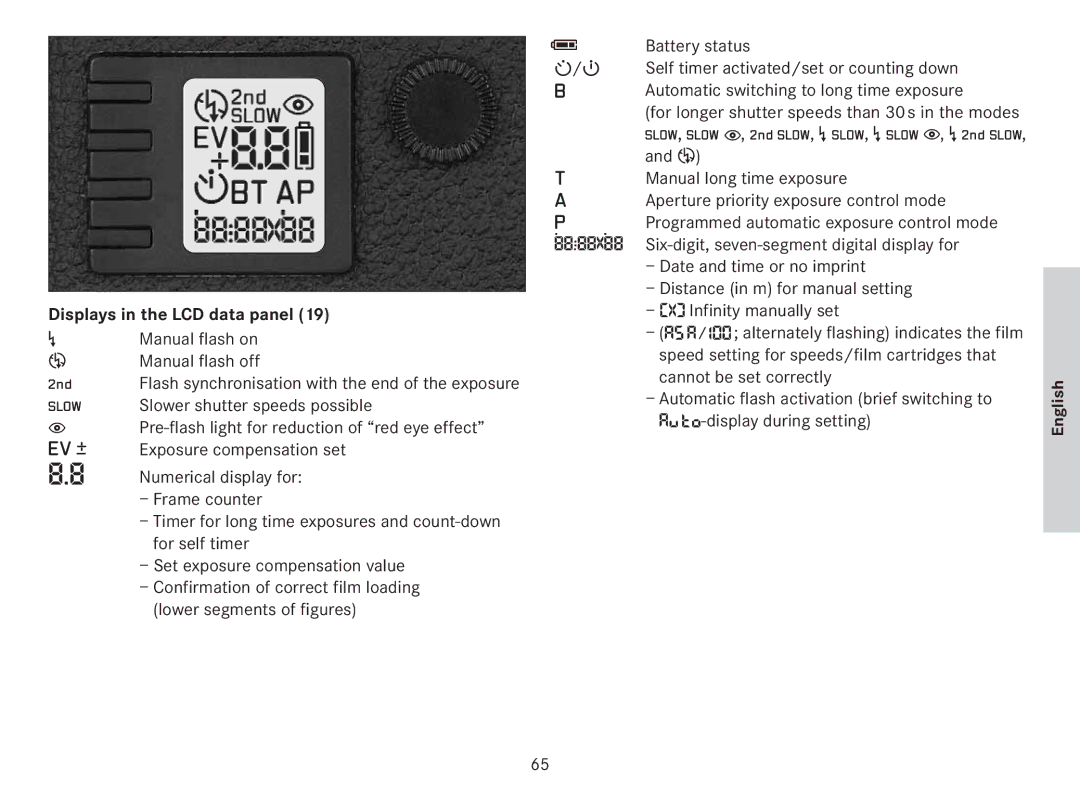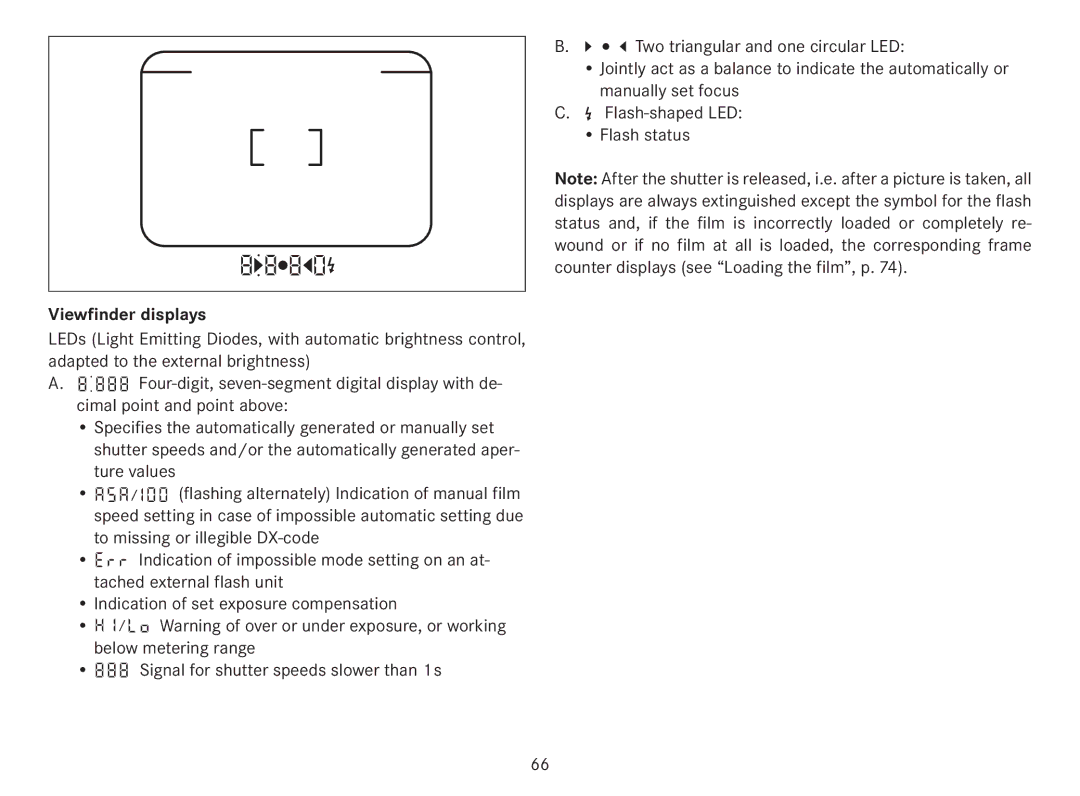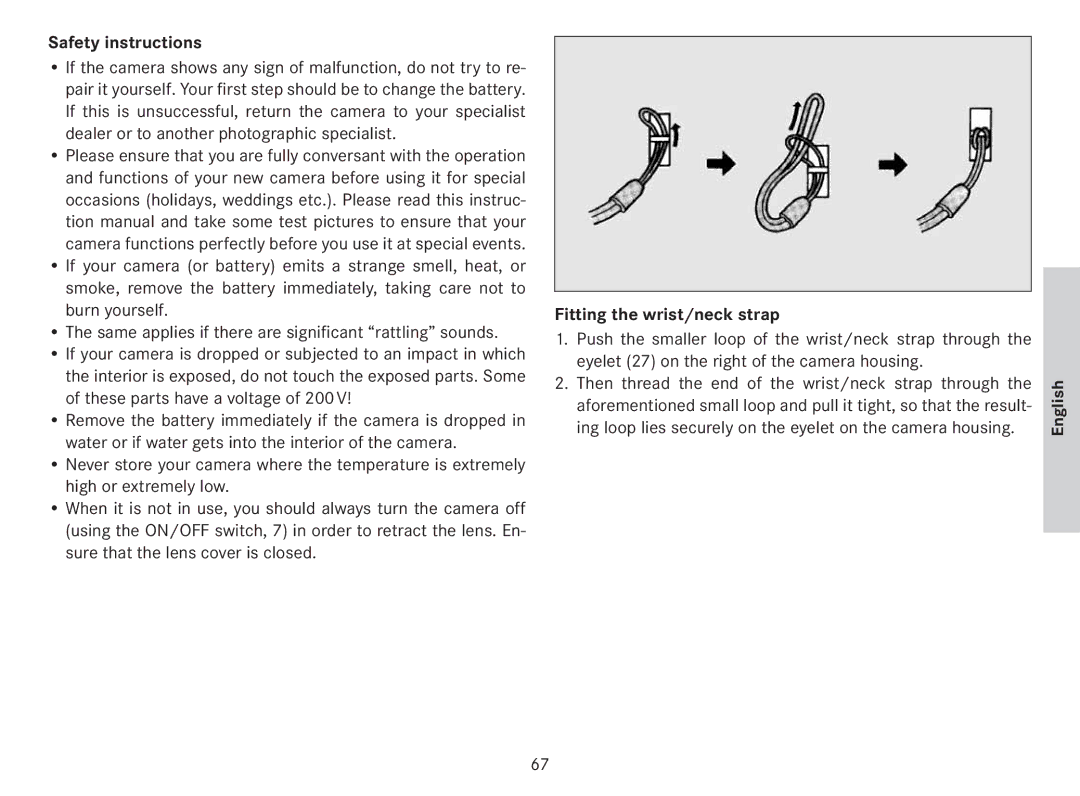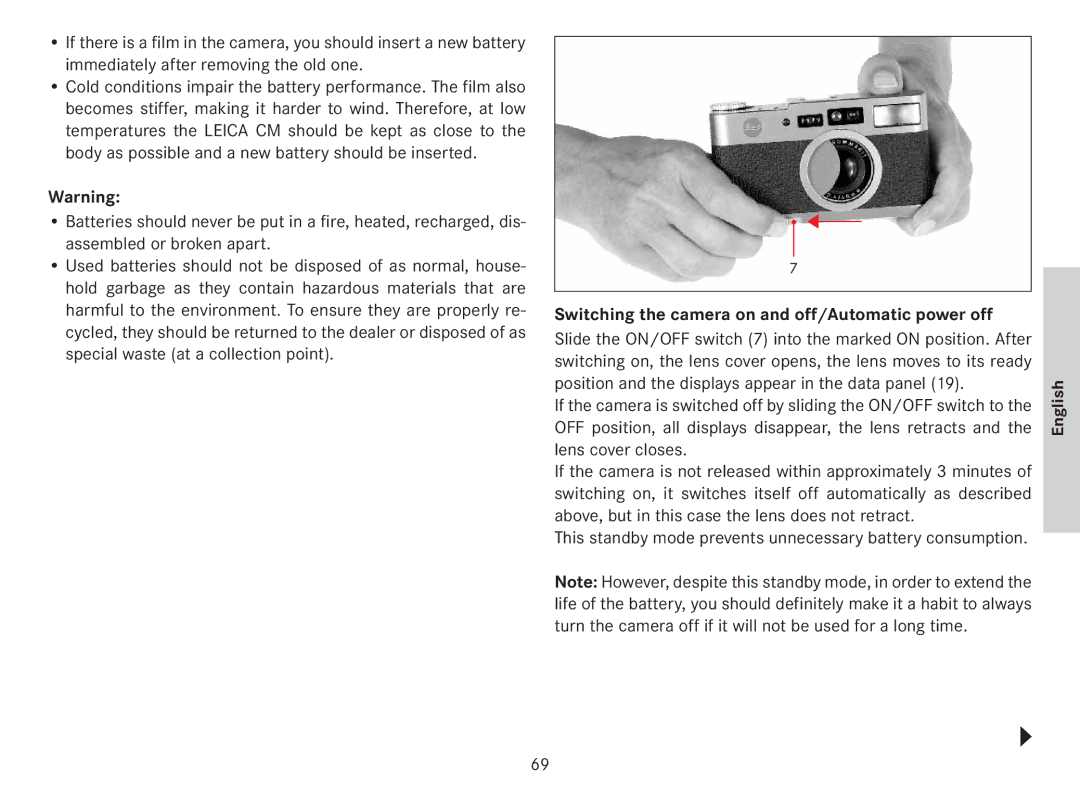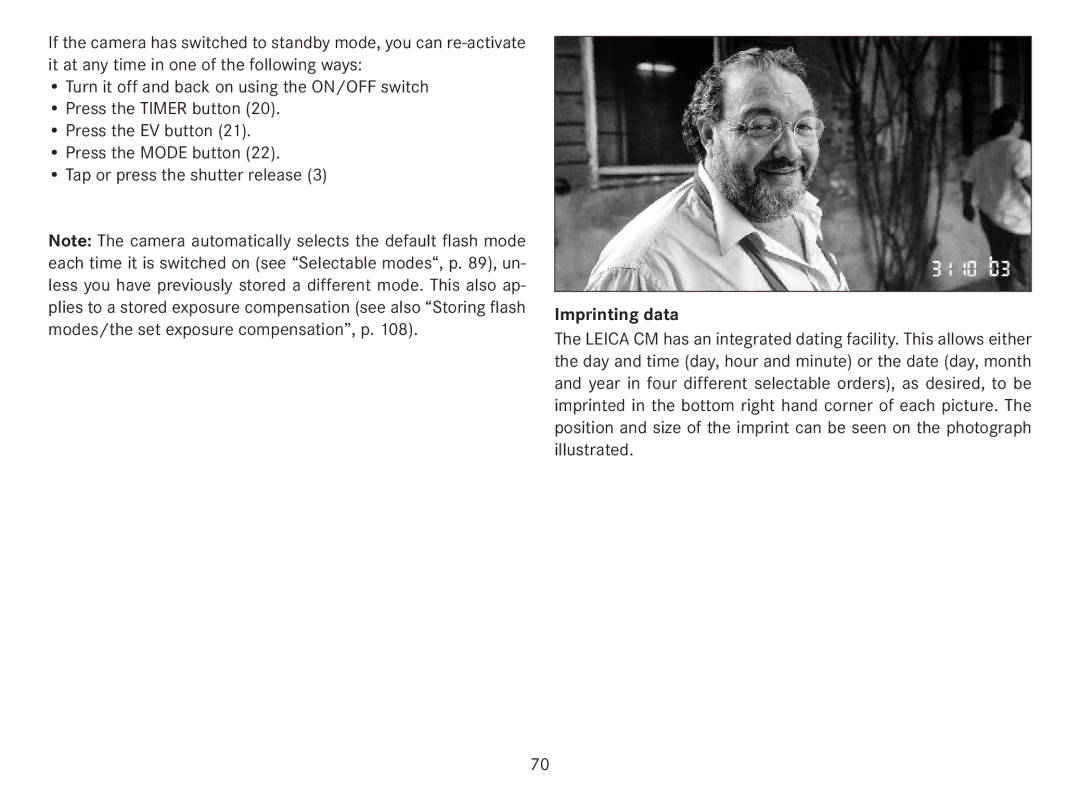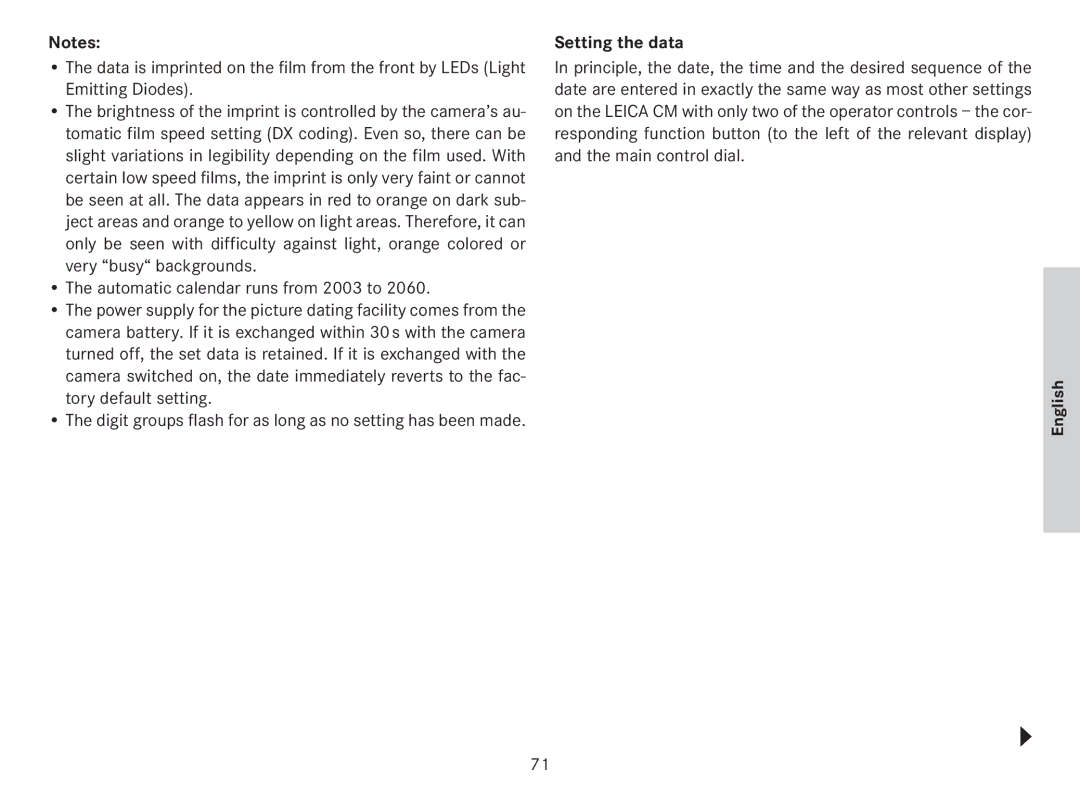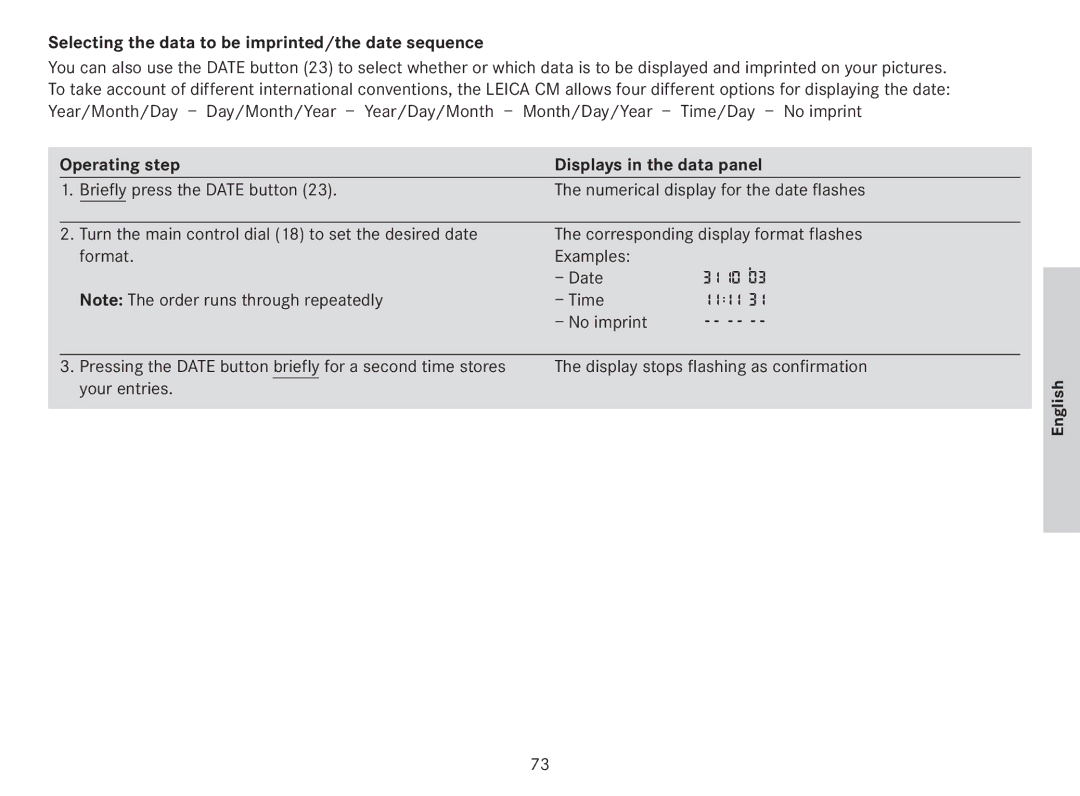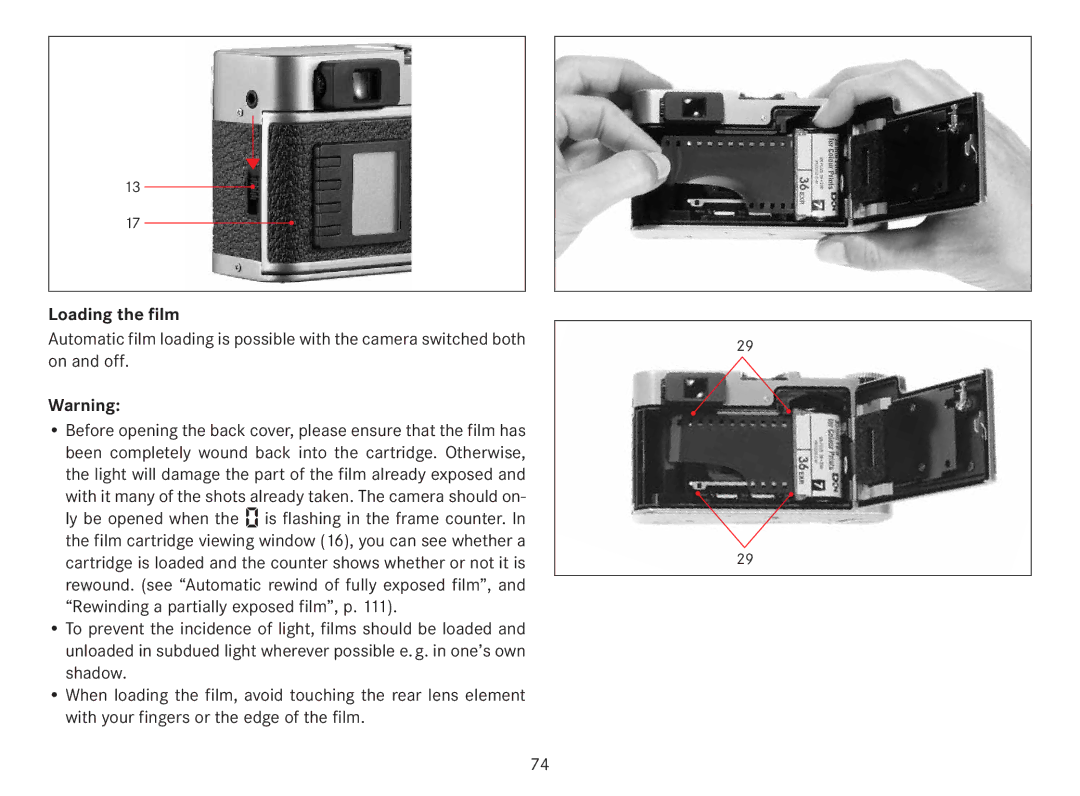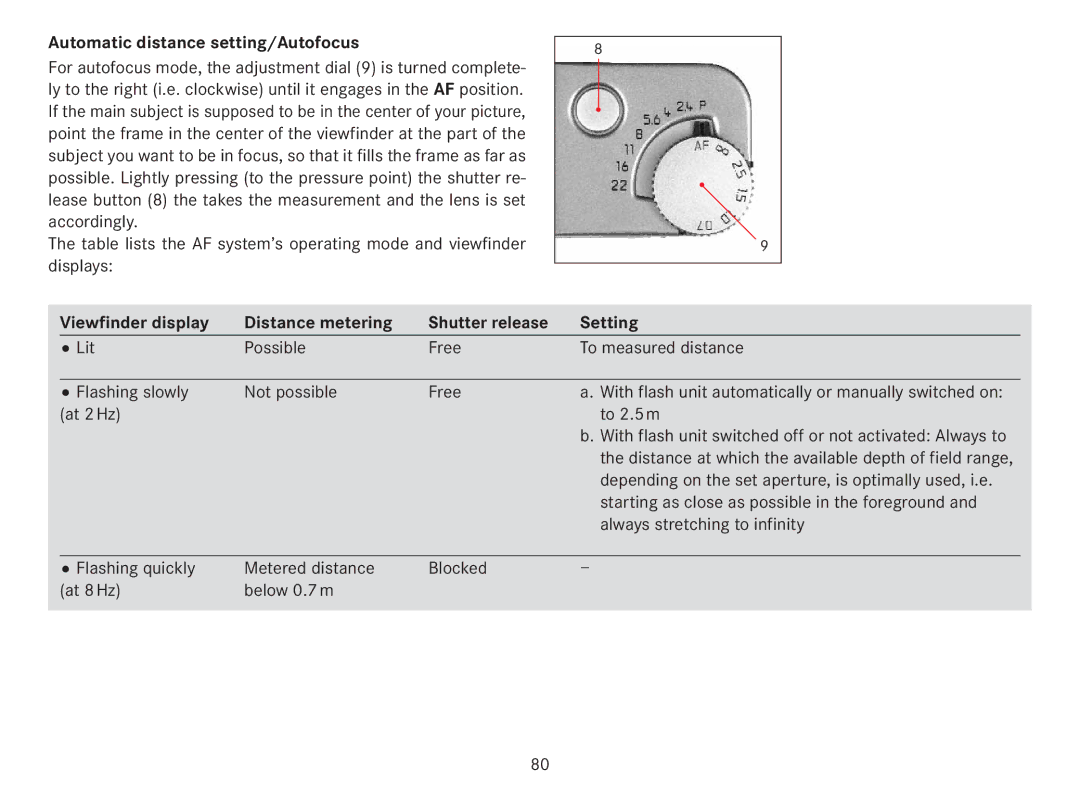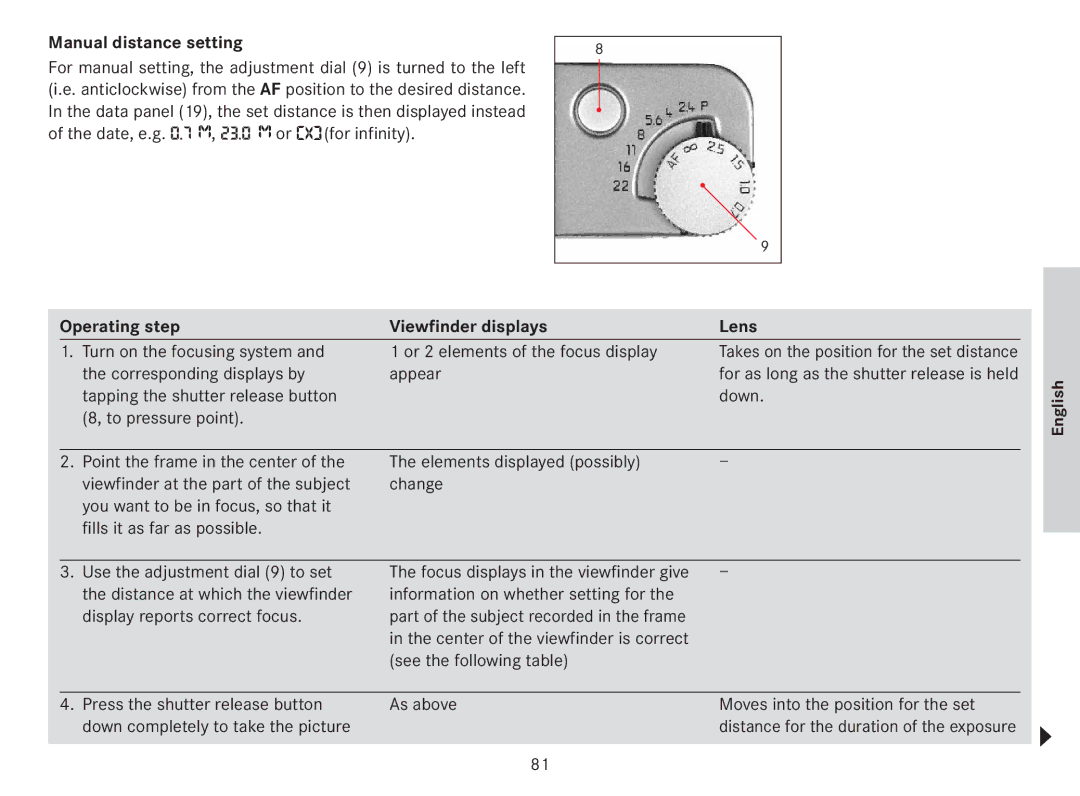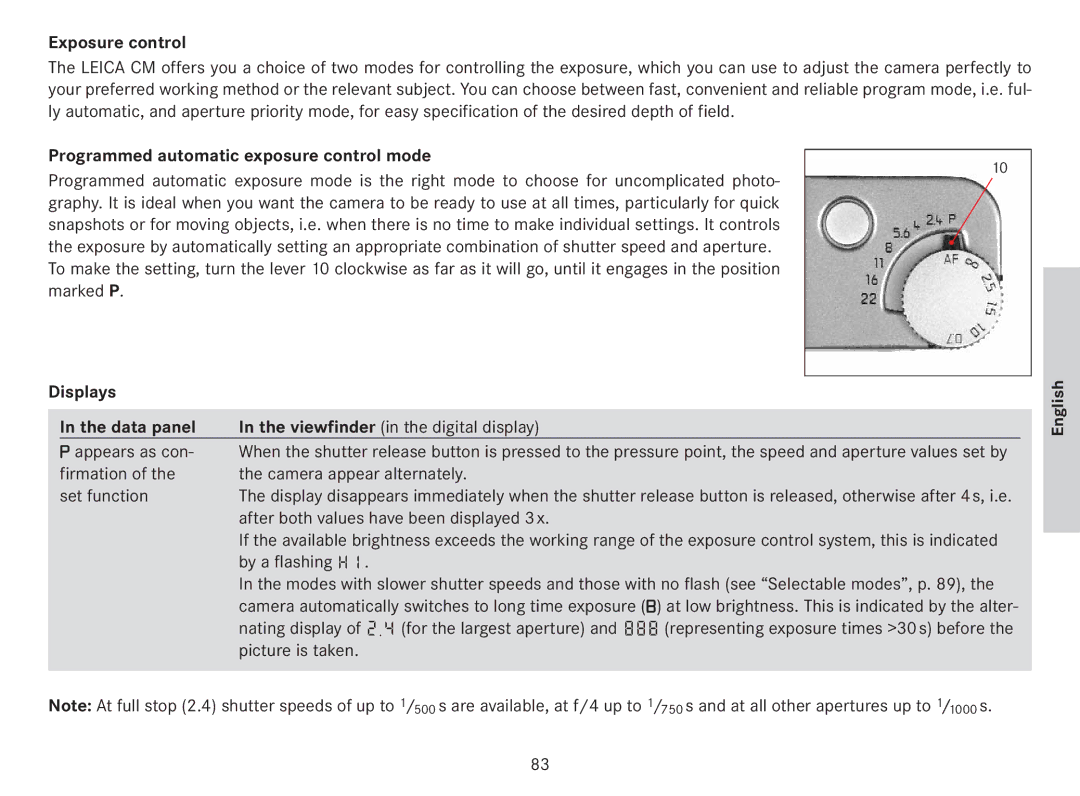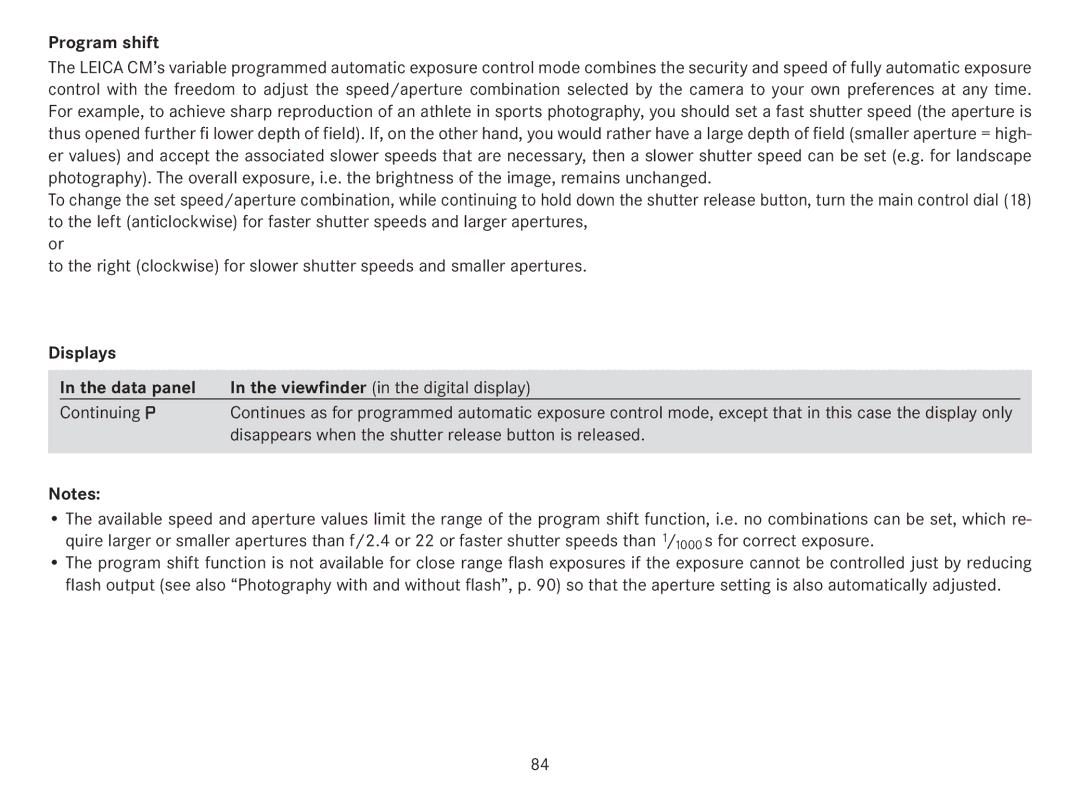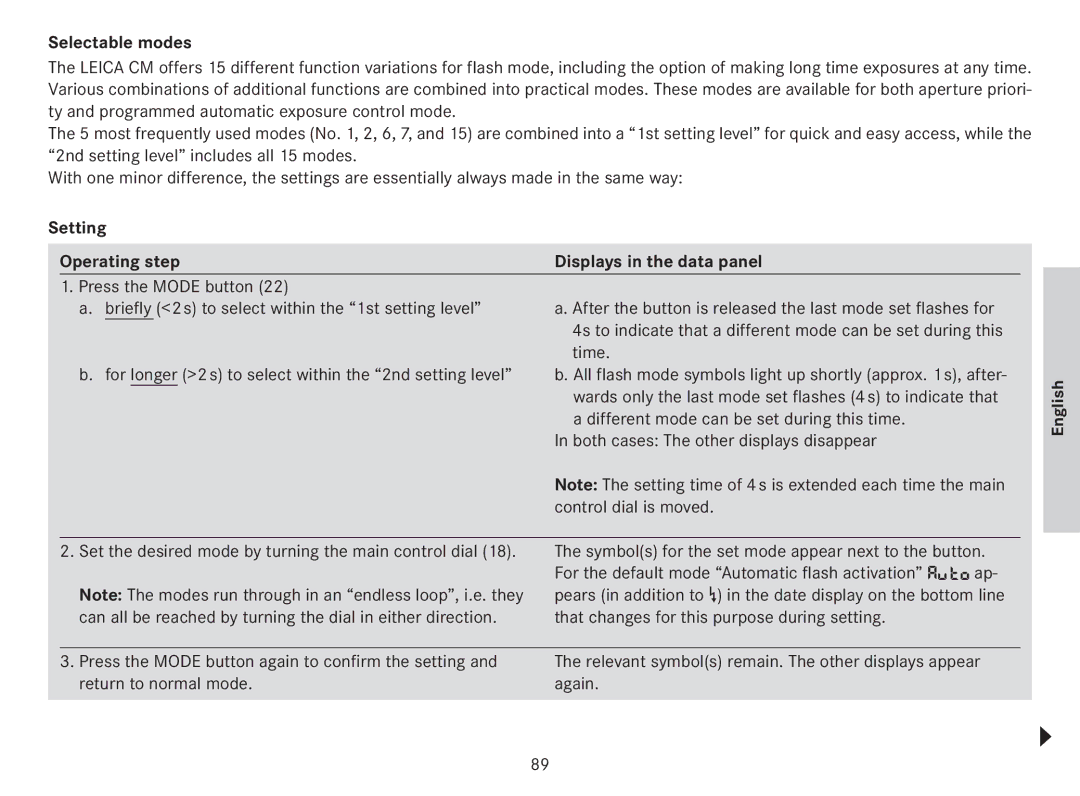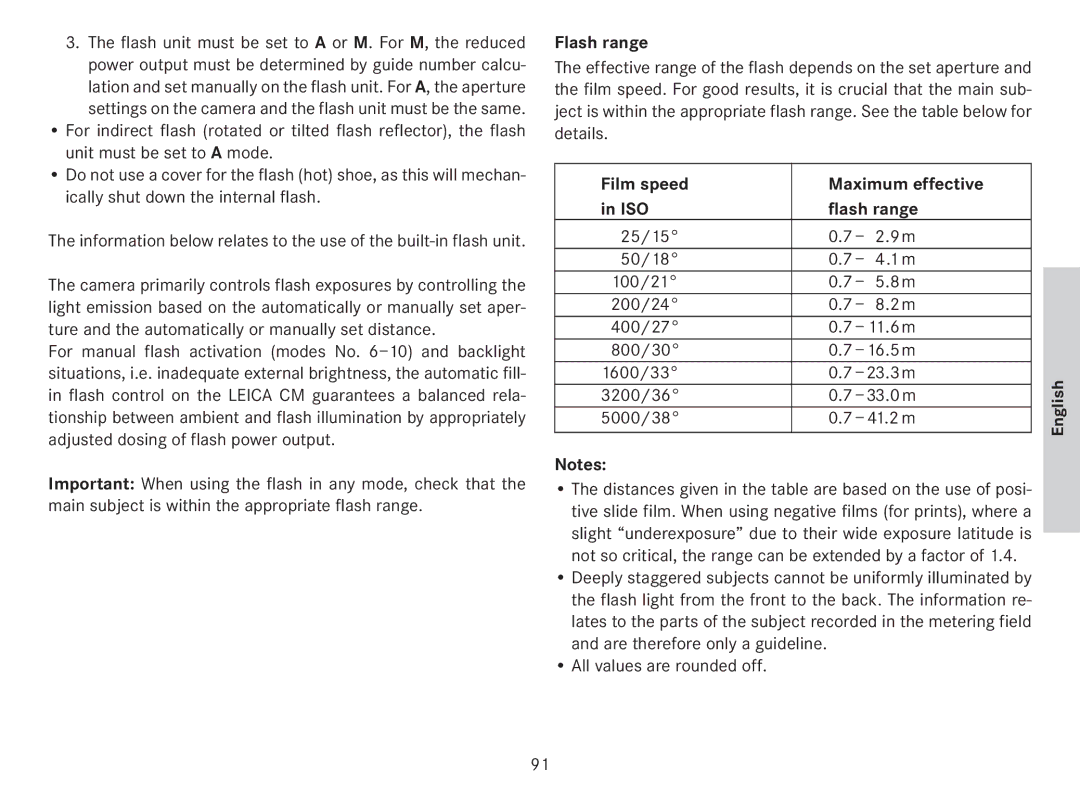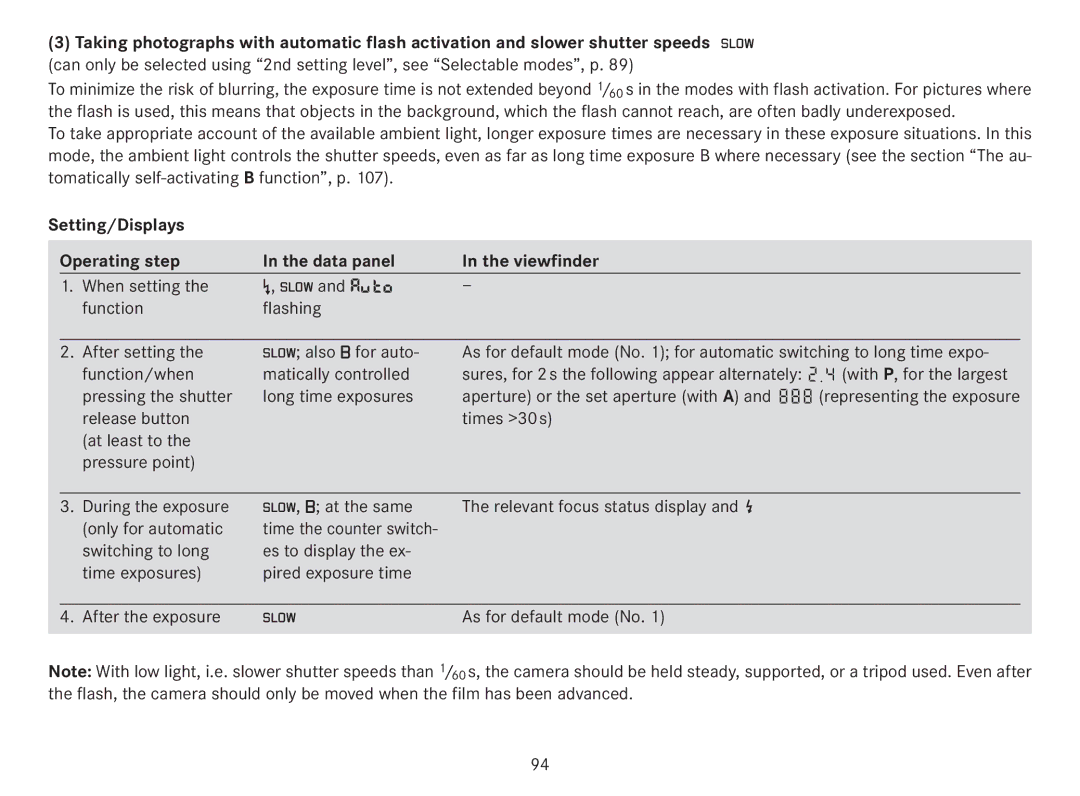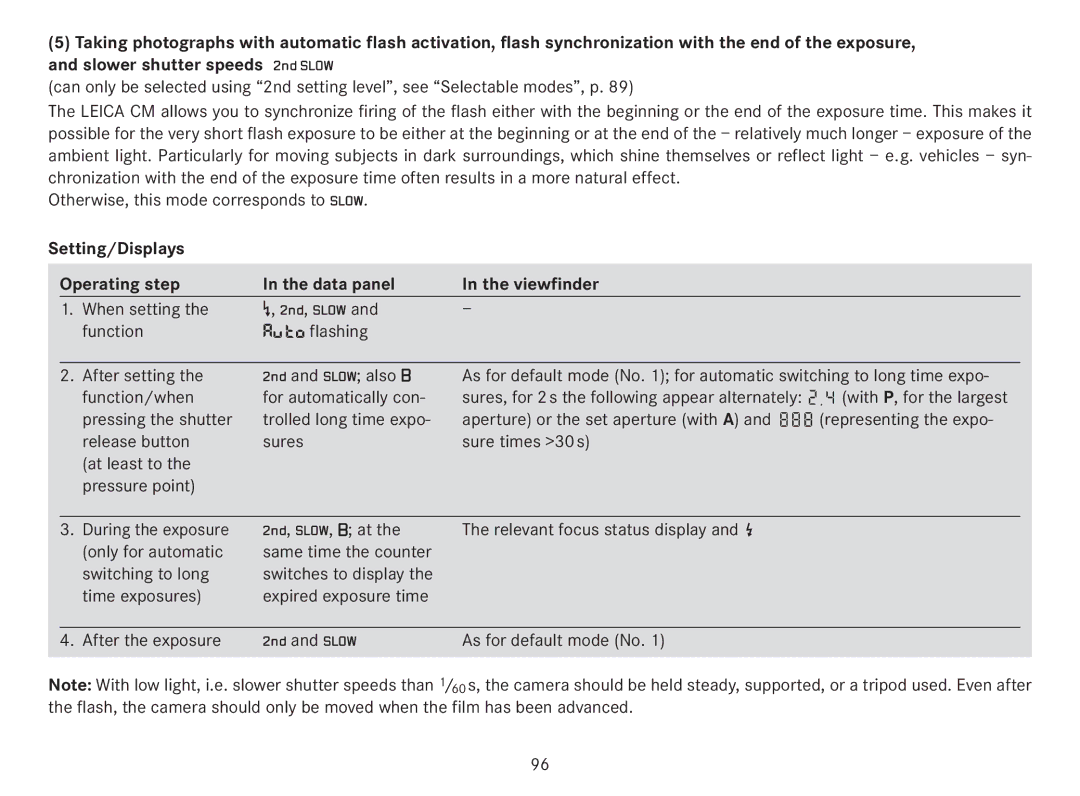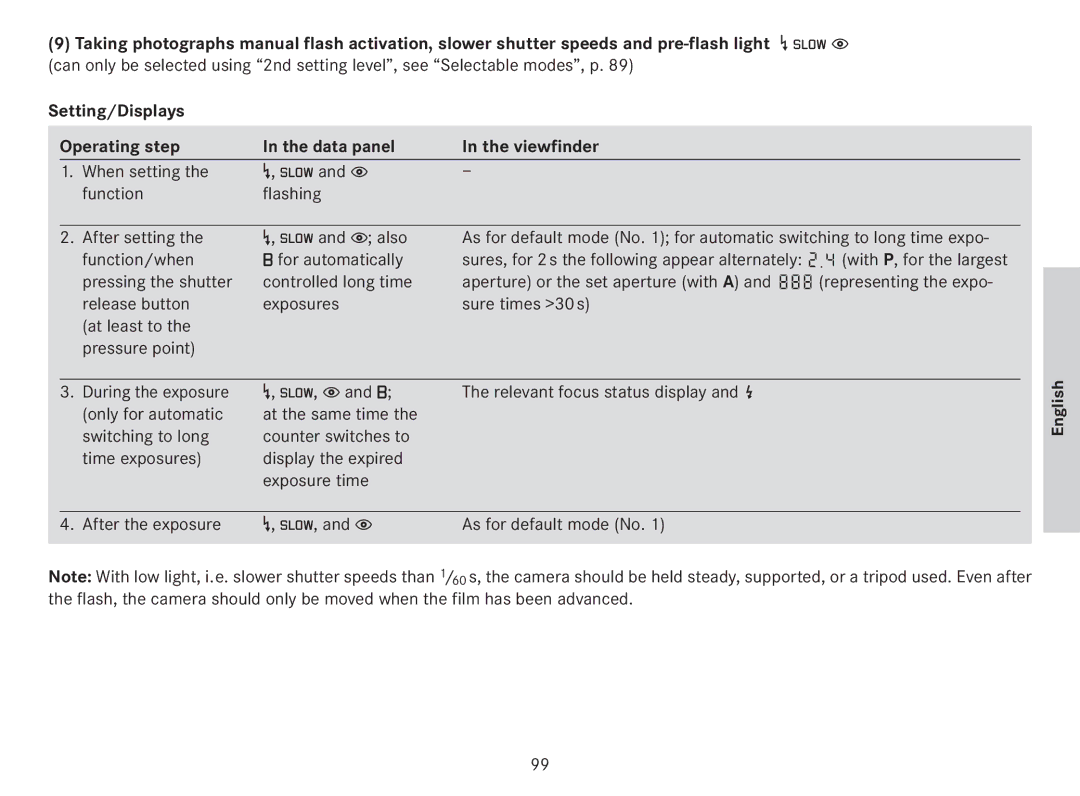Contents
Leica CM
11b 11a 1322
2932
Leica CM
Vorwort
Kurzbeschreibung
Messwertspeicherung für AF und Belichtung
Kürzeste Verschlusszeit 1/1000 s
Deutsch
Inhaltsverzeichnis
Verschlusszeiten q S
Und Vorlicht q S t
Verschlusszeiten q n S
Fotografieren mit manueller Blitz
Bezeichnung der Teile
Die Anzeigen im LCD-Datenfeld
Die Anzeigen im Sucher
Sicherheitshinweise
Deutsch Anbringen von Tragschlaufe/Tragriemen
Prüfen der Batterie
Hinweise
Achtung
Dateneinbelichtung
Der automatische Kalender reicht von 2003 bis zum Jahr
Einstellen der Daten
Bedienungsschritt
Hinweis Die Reihenfolge wiederholt sich Uhrzeit
Wählen der einzubelichtenden Daten/der Datums-Reihenfolge
Bedienungsschritt Anzeigen im Datenfeld
Einlegen des Films
Die Filmpatronenkammer 31. Der untenliegende, fe
Er mit einem weichen Blasepinsel entfernt werden
Gleichbleibend
Bedienungsschritt Fortsetzung
Verwendbare Kleinbildfilme
Richtiges Halten der Kamera
Der Sucher/Die Anzeigen im Sucher
Nahbereichs-Begrenzungen
Rahmen des Entfernungs-Messfelds
Dioptrie-Einstellung
Solche mit regelmäßigen Mustern
Fotografieren mit der Leica CM
Die Entfernungseinstellung
Automatische Einstellung der Entfernung / Autofokus
Anzeige im Sucher Entfernungsmessung Auslöser Einstellung
Ter Blende vorhandene Schärfentiefe-Bereich optimal
Nend, und immer bis unendlich reichend
Aufnahme ganz durch
Manuelle Einstellung der Entfernung
Deutsch Bedienungsschritt Anzeigen im Sucher
Anzeige im Sucher Status /erforderliche Maßnahme
Die Anzeigen Im Datenfeld
Die Belichtungssteuerung
Programmautomatik
Freigegeben wird
Programm-Shift
Im Sucher in der Digitalanzeige Weiterhin P
Zeitautomatik
Eingestellten Funk
Grundsätzlich
Stellvertretend für die Belichtungszeiten 30 s angezeigt
Speichern von Schärfe und Belichtung
Wichtig
Belichtungskorrekturen
Die Einstellung Bedienungsschritt
Page
Drücken Sie erneut die MODE-Taste zur Bestätigung der
Wählbare Betriebsarten
Drücken Sie die MODE-Taste
Fotografieren mit und ohne Blitzeinsatz
Hinweise zur Verwendung externer Blitzgeräte
Die Blitzreichweite
Filmempfindlich Maximal nutzbarer Keit in ISO Blitzbereich
Das Einstellen/Die Anzeigen Bedienungsschritt Im Datenfeld
Die Betriebsarten mit automatischer Blitz-Zuschaltung
Fotografieren mit automatischer Blitz-Zuschaltung
Deutsch
Funktion/beim Automatisch gesteuer
Bei P, für
Betätigen des Aus Ten Langzeit-Aufnah
Und B gleichzeitig
Nach der Aufnahme Und t
Funktion/beim Bei automatisch
Betätigen des Aus Gesteuerten Langzeit
Und B
Ansonsten entspricht diese Betriebsart S
Funktion/beim Lich B bei automatisch
Die Betriebsarten mit manueller Blitz-Zuschaltung
Nach der Aufnahme Und S
Funktion/beim Bei automatisch ge
Betätigen des Aus Steuerten Langzeit
Funktion/beim Zusätzlich B bei auto
Betätigen des Aus Matisch gesteuerten
S und B
Fotografieren mit manuell gesteuerten Langzeit-Aufnahmen
Page
Deutsch
Page
Deutsch
Fotografieren mit manueller Blitz-Abschaltung u
Die selbständig sich einstellende B-Funktion
Nach der Speicherung
Und die übrigen Anzeigen erscheinen wieder
Drücken Sie die TIMER-Taste
Drücken Sie erneut die TIMER-Taste zur Bestätigung der
Der Selbstauslöser
Einstellung und zur Rückkehr zum Normalbetrieb
Hinweise
Zubehör
Automatische Rückspulung des belichteten Films
Rückspulung eines teilbelichteten Films
Ganzes Bild unscharf
Was tun, wenn Fehler Ursache Abhilfe Kamera löst nicht aus
Kamera löst nicht aus und im
Fehler Ursache Abhilfe Hauptobjekt nicht scharf
Bild verschleiert oder
Partiell unscharf
Ganzes Bild oder nur ein Teil
Tipps zur Pflege der Leica CM
Technische Daten
Filmformat 24 x 36 mm
Betriebsspannung 3
Leica Akademie
Leica im Internet
Leica Infodienst
Leica Kundendienst
Foreword
Brief description
Metering memory lock for AF and exposure
Fastest shutter speed 1/1000 s
English
Contents
Self timer
Speeds q S Accessories
Troubleshooting
Technical data
Designation of parts
Battery status
Displays in the LCD data panel
Manual flash on Manual flash off
Manual long time exposure
Viewfinder displays
Safety instructions
Fitting the wrist/neck strap
Checking the battery
Close the cover again by turning it clockwise
Switching the camera on and off/Automatic power off
Imprinting data
Setting the data
Entries
Operating step
Value changes accordingly
Time
Selecting the data to be imprinted/the date sequence
Operating step Displays in the data panel
Loading the film
Constant
Was not switched on before, threads the film automatically
Compatible 35mm films
Holding the camera correctly
Distance metering field frame
Diopter settings
Viewfinder/Viewfinder displays
Distance setting
Taking photographs with the Leica CM
Automatic distance setting/Autofocus
Depending on the set aperture, is optimally used, i.e
Starting as close as possible in the foreground
Always stretching to infinity
Corresponding displays by Appear
Manual distance setting
Operating step Viewfinder displays Lens
Viewfinder display Status/Required action
Displays Data panel
Programmed automatic exposure control mode
Exposure control
Viewfinder in the digital display Continuing P
Disappears when the shutter release button is released
Program shift
Aperture priority exposure control mode
Storing focus and exposure settings
Setting Operating step
Exposure compensation
To increase the exposure, a setting of e.g. + 2.0 EV is made
Set the desired mode by turning the main control dial
Press the Mode button again to confirm the setting
Return to normal mode Again
Selectable modes
Instructions for using external flash units
Photography with and without flash
Flash range
Film speed Maximum effective ISO Flash range
3200/36 33.0 m 5000/38 41.2 m
All values are rounded off
Taking photographs with automatic flash activation
Setting/Displays Operating step Data panel
Modes with automatic flash activation
Setting/Displays Operating step Data panel Viewfinder
Function/when Matically controlled
With P, for the largest
Release button Times 30 s At least to Pressure point
At the same
Setting/Displays Operating step Data panel Viewfinder
When setting Function Flashing After setting S also B
Function/when For automatically con
After the exposure As for default mode No
Modes with manual flash activation
When setting S flashing Function After setting S also B
Function/when For automatically
English
When setting Function Flashing After setting S also
101
When setting T flashing Function After setting
103
Setting/Displays Operating step Data panel Viewfinder
105
106
Taking photographs with manual flash off u
B at the same
Automatically self-activating B function
107
Setting Operating step Displays in the data panel
Storing flash modes/the set exposure compensation
Self timer
Before the shutter is released the white
Accessories
Automatic rewind of fully exposed film
Rewinding a partially exposed film
Leather case with belt loop Leica Mini Tripod
Camera will not take a photograph
Frame counter is flashing
Button
Data panel see pp /76 Whole picture out of focus
Problem Cause Remedy Main subject out of focus
Picture is foggy or partially
Out of focus
Whole picture of part of picture
Care tips for the Leica CM
114
Technical data
115
116
Operating voltage 3
Leica info service
Leica Customer Service
Leica Academy
Leica on the Internet
Prólogo
118
Descripción breve
Mínima velocidad de obturación 1/1000 s
Español
119
Índice
Previo q S t
121
122
Designación de los componentes
Célula de medición de la exposición Sensores de autofoco
Las indicaciones en el panel de datos LCD
123
Las indicaciones en el visor
124
125
Indicaciones de seguridad
Colocación de la correa de transporte para cuello/muñeca
Comprobación de la pila
Notas
127
Atención
Conexión y desconexión de la cámara/ desconexión automática
Introducción de los datos
128
129
El calendario automático va desde el año 2003 hasta el año
Ajuste de los datos
Paso de manejo
Pulse durante largo tiempo la tecla Date 23 mín s
El valor cambia de forma correspondiente
De forma análoga a los puntos 1 y
Paso de manejo Indicaciones en el panel de datos
Colocación de la película
132
133
Porta hasta la primera instantánea
Si se ha enhebrado de forma incorrecta en el contador de
Imágenes1 intermitente
Trario parpadea el 1, es que la película no se ha colocado
135
Películas de pequeño formato utilizables
Cómo sostener correctamente la cámara
136
El visor/las indicaciones en el visor
Ajuste de las dioptrías
Fotografiar con la Leica CM
El ajuste de la distancia
Alcance infinito
Ajuste automático de la distancia/autofoco
Mente con 2 Hz Mente a 2,5 m
Ajuste manual de la distancia
Paso de manejo Indicaciones en el visor Objetivo
Indicación en el visor Estado/medida necesaria
Ajuste de distancia adecuada
Parpadea lentamente
Parpadea con rapidez Sin indicación
Las indicaciones En el panel de datos
El control de la exposición
Programación automática
Libera el disparador
Shift del programa
En el visor en la visualización digital Continua P
Modalidad de prioridad de apertura
Memorizar enfoque y exposición
Importante
Compensaciones de la exposición
El ajuste Paso de manejo
Page
El ajuste Paso de manejo Indicaciones en el panel de datos
Presione la tecla Mode
Modos de funcionamiento seleccionables
Fotografiar con y sin activación del flash
Fin de reducir el «efecto de los ojos rojos»
El alcance del flash
Sensibilidad de la Intervalo máximo de Película en ISO
Fotografiar con la activación automática del flash
Después de la toma
Funcionar El símbolo de flash se ilumina
Al ajustar la función Y a Parpadean Adicionalmente
Al accionar el dispa Para fotografías de
Rador como mínimo Exposición prolongada Tivamente
Hasta el punto de Ajustadas automática Ajustado en a y
Al ajustar la función T y a Parpadean
Y B al mismo
Al ajustar la función S y a Parpadean
S adicional
Mente B para foto
Grafías de exposición Tivamente
Los modos de funcionamiento con activación manual del flash
Al ajustar la función T parpadean
Como mínimo hasta el punto de resistencia
155
Al ajustar la función S parpadean
156
157
Al ajustar la función Y t parpadean
Después de la toma Y t
158
Al ajustar la función Y S parpadean
Después de la toma Y S
159
Page
161
Page
163
Fotografiar con la desactivación manual del flash u
164
La función B de ajuste automático
165
Tras la memorización
Recer
El disparador automático
167
Para iniciarlo, pulsar el disparador
Disparo
Accesorios
Rebobinado automático de la película impresionada
Rebobinado de una película parcialmente impresionada
Qué hacer cuando Fallo Causa Remedio La cámara no dispara
La cámara no dispara y en el panel
De datos parpadea el contador de
Toda la imagen desenfocada
Fallo Causa Remedio Objeto principal desenfocado
La imagen está velada o
Parcialmente desenfocada
Toda la fotografía o parte de ella
Consejos para el cuidado de la Leica CM
Especificaciones
173
174
Tensión de servicio 3
Academia Leica
Leica en Internet
Servicio de información Leica
Servicio de reparaciones Leica
My point of view
